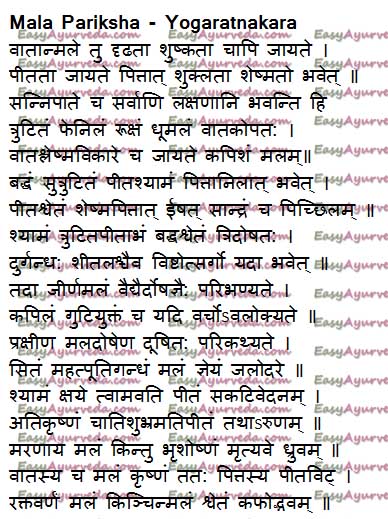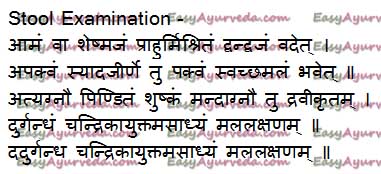Stool Examination In Ayurveda
Article by – Dr Renita D’souza
Ancient science of Ayurveda has well explained clinical examination of patient and diseases. Examination of disease and patient should be done prior to diagnosis and treatment of disease. This is based on textual knowledge, visual perception and inference.
Read related – Roga, Rogi Pareeksha: Examination Of Disease And Patient
Table of Contents
Introduction
Stool examination is mentioned by Yoga Ratnakara under eight fold examination which includes -Examination of
- Nadi – pulse
- Mutra – urine
- Mala – stool
- Jivha – tongue
- Shabdha – voice and various sound
- Sparsha – by palpation
- Drik – by inspection
- Aakriti – shape, body built
Stool examination importance
- Diagnosis of disease
- Prognosis
- Dosha involvement in vitiation
- State of digestive fire
- Stage of disease
- Presence of food toxin(ama)
- Determine the remaining life span (arista lakshana)
Read related: Constipation Causes, Ayurvedic Treatment, Home Remedies
Understanding Doshas by examining stool
Methods
Method of Stool Examination
It involves 2 method –
- Physical examination
- Test by dipping stools in water
Physical examination
Physical examination is based on color of stools, consistency, odour and formation of froth.
It is done by 4 methods –
- Inspection
- Examination of odor
- By touch
- Interrogation
Read related – 10 Factors Of Patient Examination – Dasha Vidha Atura Pareeksha
Sanskrit reference

Inspection
Examination by inspection:
Consistency of stools
Normal consistency – Semi solid like that of ripe banana.
Abnormal consistency – Hard or watery stools
Conditions causing abnormal consistency
Hard consitency
- Vata dosha imbalance
- Indigestion
- Early symptom of piles
- Piles caused due to vata dosha imbalance
- Prodromal symptom of dairrhea
- Gulma (abdominal tumor)
- Fever
- Peptic ulcers (Koshta Vrana)
- Worm infestation (Pureeshaja Krimi)
- Ascites
- Udavartha (bloating)
- Incurable sign of anemia
- Read related: Effects Of Suppression Of Urge To Defecate, Treatment
Watery stools
- Pitta dosha imbalance
- Diarrhea
- Piles caused due to imbalanced pitta
- Irritable bowel syndrome due to vata and pitta dosha
Color
Color variation in stools is usually seen when stools are afflicted with dosha, in particular disease, also depends on intake of particular medicines or food.
Conditions causing change in stool color
Black stools
- Vata dosha imbalance
- Incurable sign of jaundice
- Bleeding in gastrointestinal tract
- Intake of iron supplementing medicine
Green stools
Green stools are usually seen when bile is not digested to impart normal color to the stools as in diarrhea were the stools are passed too quickly that there is no enough time for bile to be digested.
- Halimaka jaundice
- Diarrhea
- Intake green vegetables or green food coloring
Yellow stools
- Pitta dosha imbalance
- Piles due to pitta imbalance
- Diarrhea due to pitta dosha
- Halimaka jaundice
- Fever of pitta origin
- Incurable sign of jaundice
- Jaundice
- Early sign of anemia
- Anemia due to pitta origin
- Read related: Purisha sangrahaneeya – Bowel Binding Herbs Of Charaka
White stools
- Diarrhae due to kapha dosha
Red stools
- Bleeding piles
- Fissure in ano
- Inflammatory bowel disease
- Incurable sign of jaundice
Bluish stools
- Piles, dairrhea of pitta origin
- Incurable sign of dairrhea
Frothy stools
- Vata origin – piles, diarrhea, grahani (irritable bowel syndrome)
Odor
Examination by Odor:
Abnormal odor of stools – Smell of Kunapa (dead body),Visragandi (raw meat), ama
Foul smell – diarrhea of kapha origin, anemia due to pitta, ama associated stools
Smell of dead body – Chhidrodhara (intestinal perforation), Sahaja arshas (piles)
Smell of ama – Ama associated diarrhea
Classic reference

Examination by touch:
Hot stools (ushna pureesha) – Piles of pita origin
Cold stools (sheetha pureesha) – Diarrhea of kapha origin
Dry stools
- Bloating (udavartha)
- Grahani due to vata dosha (irritable bowel syndrome)
Slimy stools
- Piles due to imbalanced kapha dosha
- Dairrhea due to kapha dosha
- Incurable sign of diarrhea
- irritable bowel syndrome due to tri dosha imbalance
Interrogation
Examination by interrogation
This is the important tool of examination which gives information regarding –
Condition of patient, frequency and quantity of stools passed, previous history of illness, presence of associated symptoms, duration of illness etc which helps for proper diagnosis and treatment of the conditions.
Read related: Fullness Of Abdomen – Ayurvedic Approach And Treatment
Quantity
Abnormal quantity of stools
Less in quantity
- Anemia
- Diarrhea of vata origin
- Fever due to imbalance of tridoshas
More quantity of stools
- Diarrhea of pita origin
- Diarrhea associated with ama
- Incurable sign of diarrhea
Frequency
Abnormal frequency of stools
More frequency
- Vata origin – Diarrhea, Irritable bowel dyndrome
Less frequency
- Vata origin – Abdominal tumor, gaseous abdominal distention, diarrhea
- Early sign of diarrhea
- Ascites
Associated symptoms
Pain – dairrhea associated with ama, vata origin dairrhea
Pain with burning sensation – Diarrhea and piles of pitta origin, fissure in ano
Passing stools with sound – Irritable bowel syndrome, and piles of vata origin, decrease in stool quantity, diarrhea associated with ama.
Read related – Ayurvedic Tongue Examinations Explained In Vaidya Sara Sangraha
Test, interpretation
Test by dipping stools in water (Jala nimajjana purisha pareeksha)
This test determines the presence of ama (fat) thereby indicating state of digestive fire which is considered as major cause for different diseases. Test is based on the behavior of stools in water.
If stools sinks in water, it indicates presence of ama, provided the patient presents other symptoms of Ama.
If it floats, indicates absence of ama in stools.
Should the feces sink or float in water?
What causes stool (feces) to float or sink and what does it mean? Thank you. We are told in the West that if your stool floats it is an unhealthy sign?
Dr JV Hebbar
Floating or sinking feces – both are considered normal. If the feces contains excessive gas or if the person has taken fiber rich food, it may float. When the person has taken a heavy meal, it could sink. The sinking or floating of stools is considered in Ayurveda to judge if a person has Ama – an imbalanced digestion and metabolism. The idea is, if the stool mass is sticky, it could stick to the toilet pan and it might sink in water as well. But this sign is considered along with other signs of Ama in the patient such as lethargy, lassitude, heaviness of the body, indigestion symptoms etc.
Read related: Symptoms Of Ama
The decision on Ama is not made just based on sinking or floating of feces. In some cases of Grahani, especially Vata type of Grahani (Malabsorption syndrome), stomach infection and pancreatitis, the fecal matter can actually float.
Read related: Stool (feces) Examination in Ayurveda
Cause for abnormal stool formation
- Low or high digestive fire
- Intake of spicy, sour, dry, rotten, under cooked,fermented, contaminated, wrong combination of food
- Excess stress, fear and anxiety
- Late night sleep or night vigils
- Skipping meals.
- Excess travel etc
Properties of stools indicating definite death of patient (Arista Lakshana)
- Stools which are too black, white, yellow or red, excessive hot
- Consumption of little quantity of food by emaciated person but excretes large amount of excreta or vice versa.
Stool influenced by Doshas –
Vata – firm, dry, fragmented, frothing, dry, as if covered with fumes (Dhumala)
Pitta – yellow,
Kapha – white
In case of Vata – Kapha imbalance, the stool will have brown colour (Kapisha).
Vata- Ptta – constipated, fragmented, yellow black
In Kapha Pitta – yellowish white, dense, sticky
In all three Dosha imbalance – mixed color and mixed features. Brown, fragmented, yellowish, whitish, constipated.
Jeerna mala
Jeerna mala – stool stuck in colon for long time –
Bad odor , cold.
When Malakshaya – decrease in stool quantity, stool looks blackish brown (Kapisha) and tablet like (Gutiyukta).
In ascites – white, bulky stool, bad smell.
In tuberculosis (Kshaya) black
In Ama Dosha (altered digestion, metabolism) – yellow, pain in hip region
Bad prognostic signs –
If the stool is dark black, very white or dark yellow or dark red in colour, excessively hot,
If the feces is having very bad smell with weird shapes and designs (Chandrikayukta) it indicates that the person is going to die soon.
Agni and Mala (Pureesha) – relationship between digestion strength and feces –
In case of very strong digestion strength, the feces gains bolus shape.
In low digestion strength, it is watery.
Click to Consult Dr Renita D’Souza
Relationship between stool and mind
My stool is very dry and hard, but I feel its my emotions and thoughts causing this. Is this possible?
Dryness is a natural quality of Vata Dosha. Dryness of stool is a Vata Symptom. Vata can get aggravated by many mental activities such as anxiety, excessive thoughts, fears, etc. These mental activities can cause increase of Vata Dosha, leading to dryness of stools.
Heavy feces but digestion is good?
Q: What is the significance of one person, vata-kapha prakriti, who does not have a very good digestion strength (Agni), but is hungry in the morning, hungry for lunch, often hungry for dinner and has most of the time a good nutrition (vegetarian, reasonable quantity, most of the time no sweets, no fried food), but is always passing ama in the stool? (the feces are always sinking in the toilets)
Dr JV Hebbar
If the person has timely hunger, takes timely food, is healthy without many health complaints, with healthy weight, sleep, etc., then it indicates that he has good agni – digestion strength.
In this case, the only not-so-ideal observation made is – fecal matter sinking in the toilet. Ideally, the fecal matter should float.
There can be 4 situations under which this can happen.
1. Increase of heaviness quality. Despite having good hunger, either person is taking slightly more quantity of food than necessary or taking lesser spices in their diet.
2. Because the person is said to be Kapha and Vata in Prakriti, there can be slight increase in the colon (pureesha vaha srotas).
3. There could be samana vata and apana vata imbalance in the colon, which play a role in forming stools with healthy size and shape.
If there are no other health complaints, this one alone might not be a serious enough symptom to be given aggressive treatment. However, below mentioned remedial measures can be considered.
Correction of Agni – If during the assessment, if agni was actually found to be low, then Chitraka – Leadwort – Plumbago zeylanica, Ginger, pepper, cumin seeds are some options. .
If the patient has constipation or hard bowels, – Vata Anulomana herbs, which ensure downward movement of Vata dosha – fenugreek, asa foetida, Haritaki – Chebulic myrobalan, Triphala – Amla, Haritaki, Vibhitaki can be considered.
Read: Constipation causes, remedies, treatment
If frequent loose stools, grahi – absorbent medicines – Musta – Nut grass (root) – Cyperus rotundus, Kutaja – Bark of Holarrhena antidysenterica, Chandana – Sandalwood etc. are administered usually with buttermilk.
Read: Buttermilk benefits and remedies
4. Excessively heavy diet – with daily use of black gram (urad dal), fried foods and non veg.









2 comments
Nagabharana Adiga
Should our stool contain ama (are we excreting it through stool) or should it not contain ama?
Dr J V Hebbar MD(Ayu)Author
It should not contain.